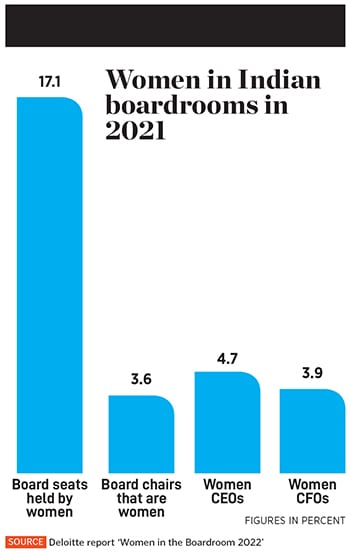
India's 100 Richest: Why is it still a man's world?
Only nine out of the 100 richest Indians in 2022 are women. Even globally, the number of female billionaires is not very promising in the face of continuing social, cultural and financial challenges
 Women haven’t been given equal opportunities.” In earlier days in India, where, on one hand, boys were encouraged to pursue higher studies, girls, on the other hand, were relegated to domestic household work so that they can be married off.
Illustration: Chaitanya Dinesh Surpur
Women haven’t been given equal opportunities.” In earlier days in India, where, on one hand, boys were encouraged to pursue higher studies, girls, on the other hand, were relegated to domestic household work so that they can be married off.
Illustration: Chaitanya Dinesh Surpur
As the world was entering a new millennium in 2000, only 11 women worldwide, a miniscule number, were a part of the billionaires club, as per Forbes. Today, that number has increased to 327, but it’s still a mere 12.25 percent of the total 2,668 billionaires on the planet.
Bring India into this statistic, and it’s far worse. Let’s analyse a 10-year time period for Forbes India’s list of 100 Richest Indians, beginning 2013. Since then, the number of women who have featured on the list has only gone up slightly. In fact, if we just consider the self-made women billionaires, in 2013, there were five women on the list, and this year the number remains the same. (excluding families). Nine female billionaires compared to 91 men.
This year, apart from Savitri Jindal of the OP Jindal Group, Biocon’s Kiran Mazumdar-Shaw, and USV’s Leena Tewari, who have all been part of the Forbes India Rich List for many years, the list also includes Falguni Nayar of Nykaa, a new entrant, and Anu Aga of Thermax, a returnee who last featured on the list in 2014.
Meher Pudumjee, chairperson, Thermax, who is carrying forward her mother Anu Aga’s legacy, believes the reason may lie in the fact that in most family businesses, the company and wealth goes down from father to son. Hence, it would be difficult to find women who are billionaires as compared to men.





 For women, household, maternity and other caregiving responsibilities often lead to a break in their career path, which isn’t something men necessarily have to accommodate. “These breaks can impact a woman’s growth trajectory,” adds Goenka.
For women, household, maternity and other caregiving responsibilities often lead to a break in their career path, which isn’t something men necessarily have to accommodate. “These breaks can impact a woman’s growth trajectory,” adds Goenka. 
 Women-led enterprises are mostly focussed on textile, food processing, and services like beauty salons, says Nikore. Considering the general growth of startups reaching the unicorn status in India, a number of them are coming from the technology sector, which makes it important to reverse the low representation of women in technology.
Women-led enterprises are mostly focussed on textile, food processing, and services like beauty salons, says Nikore. Considering the general growth of startups reaching the unicorn status in India, a number of them are coming from the technology sector, which makes it important to reverse the low representation of women in technology. 




